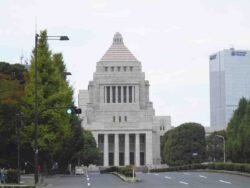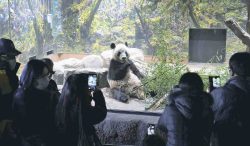
Seedlings of the tobacco relative benth, Nicotiana benthamiana, are seen in simulated lunar soil in a laboratory at the China Agricultural University in Beijing in this undated photo obtained on Nov. 9.
10:00 JST, December 6, 2023
WASHINGTON (Reuters) — If humankind is ever to establish long-term bases on the moon, there will be a need for a regular source of food. It is not practical, however, to think you can plant corn or wheat in plain lunar soil in greenhouses on the moon and expect a bumper crop — or any crop at all.
But scientists are taking steps toward making moon agriculture a real possibility. Researchers said last month they have found a way to turn inhospitable lunar soil fertile by introducing bacteria that enhance the availability of phosphorus, an important plant nutrient.
They performed experiments growing a relative of tobacco using simulated moon soil, more properly called lunar regolith, in a laboratory in China. They found that such soil treated with three species of bacteria produced plants with longer stems and roots as well as heavier and wider clusters of leaves compared to the same soil without the microbes.
The action of the bacteria, the researchers said, made the soil more acidic. This resulting low pH environment caused insoluble phosphate-containing minerals to dissolve and release the phosphorus in them, increasing phosphorus availability for the plants.
“The importance of these findings is that we may be able to use these microbes to turn the lunar regolith into bio-friendly substrate for plant cultivation in future lunar greenhouses,” said researcher Yitong Xia of the China Agricultural University in Beijing, lead author of the study published in the journal Communications Biology.
In a study published last year, researchers in the United States grew a flowering weed called Arabidopsis thaliana in 12 thimble-sized containers, each bearing a gram of actual moon soil collected during NASA missions more than a half century ago.
Arabidopsis, also called thale cress, is a plant widely used in scientific research. In that study, Arabidopsis did grow, but not as robustly in the lunar soil as in volcanic ash from Earth used for comparative purposes, suggesting that lunar soil could use a little help to become more fertile.
The new research involved benth, scientific name Nicotiana benthamiana, another plant often used in research.
The study used simulated regolith rather than the real thing because genuine lunar soil, as one might imagine, is in short supply on Earth. The researchers used volcanic material from the Changbai mountains of China’s Jilin Province to create soil with similar chemical and physical properties to lunar regolith.
The three bacteria used in the study were: Bacillus mucilaginosus, Bacillus megaterium and Pseudomonas fluorescens. The researchers tested other bacteria as well, but those did not produce the same beneficial effects.
“Considering the huge scientific and economic potential of the moon, we will need to set up manned lunar bases in the future. But how can we provide food, oxygen and water for the crew members? Of course we can carry them to the moon by rockets, but that is economically unsustainable. A greenhouse for plant cultivation on the moon could greatly reduce the need of Earth-moon transportation,” Xia said.
A plant cultivation system on the moon could help meet long-term food and oxygen requirements for human crews, Xia added. Plants produce oxygen as a byproduct of photosynthesis, the biological process in which they turn sunlight into energy.
“We have several ways to grow plants on the moon, including transporting horticultural soil to the moon, building up a hydroponic system [growing plants without soil] or using soil substitute like hydrogels [gels whose liquid component is water]. Those methods do not need lunar soil, but all of them would consume huge carrying capability on rockets, making these plans very expensive,” Xia said.
“In contrast, our technique, which is a kind of in-situ resource utilization, applies microbial improvement to the lunar soil, making it more fertile and capable for plant cultivation,” Xia added. “Our study achieved the same goal with much less consumption of carrying capability comparing with other plans.”
"Science & Nature" POPULAR ARTICLE
-

Mass Oyster Die-Offs Confirmed in Japan’s Seto Inland Sea; High Water Temperature Cited as Primary Cause
-

Genome Study Reveals Milestone in History of Cat Domestication
-

Big Leap in Quest to Get to Bottom of Climate Ice Mystery
-

Security Camera Footage Vulnerable to Outside Access; Investigation Finds 3,000 Pieces Exposed Online
-

Star-eating Black Hole Unleashes Record-setting Energetic Flare
JN ACCESS RANKING
-

Japan’s Hopes for Seafood Exports Shot Down in China Spat
-

Keidanren Chairman Yoshinobu Tsutsui Visits Kashiwazaki-Kariwa Nuclear Power Plant; Inspects New Emergency Safety System
-

Japan to Charge Foreigners More for Residence Permits, Looking to Align with Western Countries
-

Imports of Rare Earths from China Facing Delays, May Be Caused by Deterioration of Japan-China Relations
-

Japan Exports Rise in October as Slump in U.S. Sales Eases























